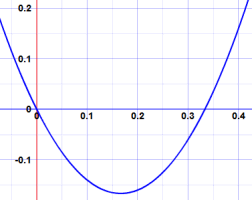THE EASY WAY TO FACTORISE NASTY QUADRATICS
- Get link
- X
- Other Apps
Factoring Quadratics
To "Factor" (or "Factorise" in the UK) a Quadratic is to:
find what to multiply to get the Quadratic
It is called "Factoring" because we find the factors (a factor is something we multiply by)
Example:
Multiplying (x+4) and (x−1) together (called Expanding) gets x2 + 3x − 4 :
Just to be sure, let us check:
(x+4)(x−1) = x(x−1) + 4(x−1)
= x2 − x + 4x − 4
= x2 + 3x − 4 

Did you see that Expanding and Factoring are opposites?

Common Factor
First check if there any common factors.
Example: what are the factors of 6x2 − 2x = 0 ?
6 and 2 have a common factor of 2:
2(3x2 − x) = 0
And x2 and x have a common factor of x:
2x(3x − 1) = 0
And we have done it! The factors are 2xand 3x − 1,We can now also find the roots (where it equals zero):
- 2x is 0 when x = 0
- 3x − 1 is zero when x = 13

Example: what are the factors of 2x2 + 7x + 3 ?
No common factors.Let us try to guess an answer, and then check if we are right ... we might get lucky!
We could guess (2x+3)(x+1):
(2x+3)(x+1) = 2x2 + 2x + 3x + 3
= 2x2 + 5x + 3 (WRONG)
How about (2x+7)(x−1):= 2x2 + 5x + 3 (WRONG)
(2x+7)(x−1) = 2x2 − 2x + 7x − 7
= 2x2 + 5x − 7 (WRONG AGAIN)
OK, how about (2x+9)(x−1):= 2x2 + 5x − 7 (WRONG AGAIN)
(2x+9)(x−1) = 2x2 − 2x + 9x − 9
= 2x2 + 7x − 9 (WRONG AGAIN)
Oh No! We could be guessing for a long time before we get lucky.= 2x2 + 7x − 9 (WRONG AGAIN)
A Method For Simple Cases
Luckily there is a method that works in simple cases.With the quadratic equation in this form:

Example: 2x2 + 7x + 3
ac is 2×3 = 6 and b is 7
So we want two numbers that multiply together to make 6, and add up to 7
In fact 6 and 1 do that (6×1=6, and 6+1=7)
ac is 2×3 = 6 and b is 7
So we want two numbers that multiply together to make 6, and add up to 7
In fact 6 and 1 do that (6×1=6, and 6+1=7)
How do we find 6 and 1?
It helps to list the factors of ac=6, and then try adding some to get b=7.
Factors of 6 include 1, 2, 3 and 6.
Aha! 1 and 6 add to 7, and 6×1=6.
Rewrite 7x with 6x and 1x:
Step 3: Factor the first two and last two terms separately:
2x2 + 6x + x + 3
The first two terms 2x2 + 6x factor into 2x(x+3)
The last two terms x+3 don't actually change in this case
So we get:
Step 4: If we've done this correctly, our two new terms should have a clearly visible common factor.The last two terms x+3 don't actually change in this case
So we get:
2x(x+3) + (x+3)
In this case we can see that (x+3) is common to both terms, so we can go:
Done!
Check: (2x+1)(x+3) = 2x2 + 6x + x + 3 = 2x2 + 7x + 3 (Yes)
Much better than guessing!
Start with:2x(x+3) + (x+3)
Which is:2x(x+3) + 1(x+3)
And so:(2x+1)(x+3)
Check: (2x+1)(x+3) = 2x2 + 6x + x + 3 = 2x2 + 7x + 3 (Yes)
Let's see Steps 1 to 4 again, in one go:
| 2x2 + 7x + 3 |
| 2x2 + 6x + x + 3 |
| 2x(x+3) + (x+3) |
| 2x(x+3) + 1(x+3) |
| (2x+1)(x+3) |
OK, let us try another example:
Example: 6x2 + 5x − 6
Step 1: ac is 6×(−6) = −36, and b is 5List the positive factors of ac = −36: 1, 2, 3, 4, 6, 9, 12, 18, 36
One of the numbers has to be negative to make −36, so by playing with a few different numbers I find that −4 and 9 work nicely:
−4×9 = −36 and −4+9 = 5
Step 2: Rewrite 5x with −4x and 9x:
6x2 − 4x + 9x − 6
Step 3: Factor first two and last two:
2x(3x − 2) + 3(3x − 2)
(2x+3)(3x − 2)
Check: (2x+3)(3x − 2) = 6x2 − 4x + 9x − 6 = 6x2 + 5x − 6 (Yes)
- Get link
- X
- Other Apps
